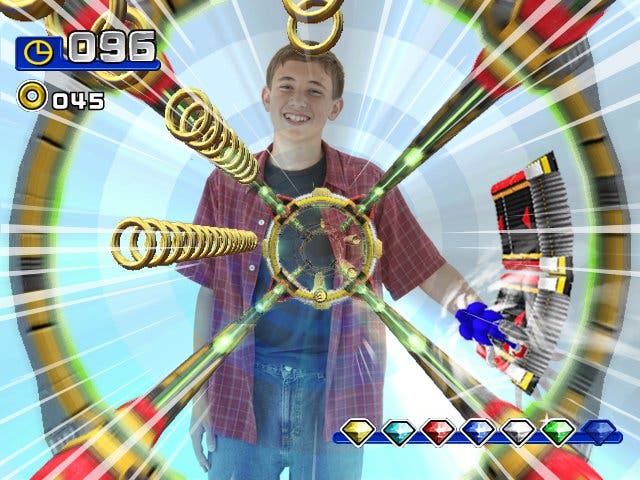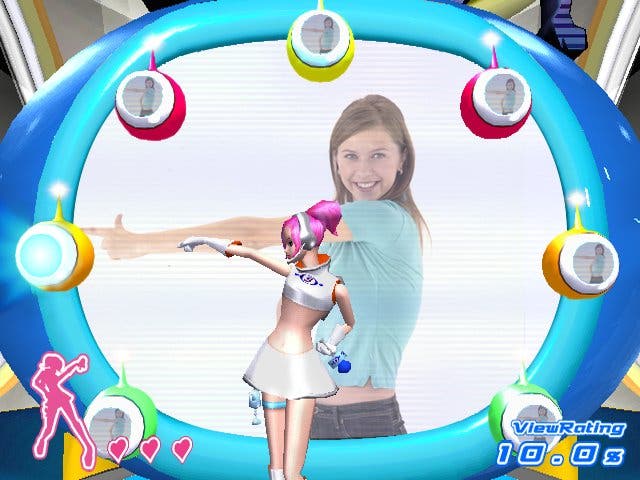SEGA SuperStars
In our final look at SuperStars pre-release, we tackle NiGHTS, Puyo Pop, Monkey Ball, Space Channel 5 and ChuChu Rocket, and there's not a dull moment between them.
Just when you thought it was safe to wind up the EyeToy cable and bury it under a mountain of tacky control pads, eh? Your lounge, and the neighbours living downstairs, may never forgive you for the havoc SEGA SuperStars is going to rain down upon them, but having now seen and played with the complete suite of mini-games that make up SEGA's first EyeToy title (and hopefully not its last), we reckon it's worth the Doritos crunched into the couch cushions by a cycle of friends' arses.
It's probably even worth the incessant buzzing at the door asking you kindly to stop jumping up and down whenever Ulala does it, and demanding to know whether it's really necessary to play the Crazy Taxi "scream loudest to pick up passengers" game at 2:30 in the morning. But just pull out a smooth line you heard off TV last week and it'll be fine. "Do you rent or own?" "What?" "Those wings. You angel."
"But, but... this is an EyeToy game!" you cry (and not at your neighbour). "Surely it's just a couple of hours of fun before it inevitably gets binned in favour of SingStar/Dancing Stage/PES/whatever the party game du jour happens to be?" The answer is it that while some of the games are notably prosaic, most make inventive use of the camera, and taken as a whole the package arguably has the potential to become the post-pub party game of choice.
Pop Star

Take Puyo Pop, for example. Adapting a puzzle game to work on EyeToy sounds difficult (and strange at that), but the way the developer handles it is both elegant and satisfying. Quite simply, whereas before a sequence of blobs fell from the sky and you had to arrange them into groups, here a sequence of blobs streams from the sky and you have to cup your arms to try and catch them and guide them into one of four colour-coded holders. Avoiding the bomb blobs.
It's a sight to see, and technically a very interesting use of the hardware - so much so that you have to pose three times before starting so it can calibrate itself. On paper though it might sound a little dull or even confusing. So: imagine you're at a party. There are balloons bobbing through the air on the crests of waving arms. As the balloon heads in your direction, you hold your arm up and poke it with your finger. Now, imagine there are loads of balloons, they're a bit smaller, and you're using the top-side of both of your arms to keep them from falling to the ground - in this case directing them into little coloured scoops, two on either side of you - and you've got it. Once you've seen it in action, you want to do nothing less than play it.
You'll also have to keep your arms held high for Monkey Ball and NiGHTS, both of which rely on your holding your arms out like a pair of wings and then moving them as one to turn. In the case of NiGHTS, you're soaring on gusts of wind, trying to weave through rings in the sky and collect other bits and bobs; visually it is NiGHTS, and, if it's been fine-tuned since we last saw it, it could be one of those Superman moments when you first get to play it. Or a bit like Pilotwings - without the landing.
Monkey Ball, on the other hand, looks exactly like Monkey Ball - there's a little monkey in a ball, and he needs to be led around a course scattered with holes in the floor and through the finish line. But you control the ball by raising and lowering your arms, as if you're tipping forward or back. You can speed up and slow down the ball, and turning is much the same as NiGHTS, so that sense of inertia in trying to get your monkey to stop going in one direction and head off in another remains palpable.
I'm A Rocket Man

Alongside the puzzling adaptations and the puzzle adaptations, then, we have ChuChu Rocket, which pops up in SuperStars as a potential first - a bona fide EyeToy puzzle game. And it works very well. As you may remember if you ever played it on the Dreamcast, ChuChu involves guiding a bunch of mice to a rocket ship as they march inexorably round a maze, and helping them to avoid contact with the mouse-munching cats, and to avoid falling into black pits of despairing rodents. And although it's simplified, SuperStars' rendition of ChuChu is nevertheless very faithful.
Faced with a walkway running round the inside of the screen like the edge of a square, with a path branching off towards a rocket ship in the centre, the idea is to hold your hand over one or two of four different coloured switches, each of which activates a bridge at a different point on the circuit. As your groups of mice and cats march round, you want to stop as many of the mice as possible tumbling into the abyss, and not let that many cats through. When you see somebody else play it, it looks easy. When you try and do it yourself, you realise it requires a surprising degree of coordination.
On top of that, SuperStars also boasts a pair of rhythm-action mini-games - based on Samba de Amigo and Space Channel 5. Samba is simple but effective. Instead of shaking maracas at three different heights and striking the odd pose as you may have done on the Dreamcast, you shake your hands at pairs of icons suspended at three different heights - in time with the drum-beat of whatever song you're listening to - and strike poses with your hands when prompted. We've yet to get the full listing of songs you can play in Samba, but there will be quite a few.
Space Channel 5, on the other hand, has had us dancing like, well, monkeys, if the similarity of movement in SC5 and Monkey Ball is anything to go by. It's a dancing game where, as it was on the DC and PS2, the objective is to match the moves that budding reporter Ulala makes as she dazzles the locals with her fleet-footedness. So when she points, points, points-points-points, you have to point, point, point-point-point at whichever of the icons dotted around the screen she happens to be jabbing her fingers at.
Obscurer
And that's by no means everything. Sonic involves guiding the blue hedgehog around the inside of a tube as he collects coins, picks up chaos emeralds and dodges spiky mines; Virtua Fighter has you punching at and blocking the attentions of various familiar combatants; Billy Hatcher is the platform game remade, complete with egg-rolling and enemy-squashing; while Crazy Taxi is, as we mentioned at the start, all about hailing a cab by making as much noise and waving as furiously as you can. And while Virtua Striker (head a ball into balloons) and House of the Dead (slap zombies as you trawl through spooky environments on rails) may not be quite as exciting as some of the others, they're still just as good as anything in EyeToy Play.
Whether they'll stand up to SCEE London Studio's attempt to reinvigorate EyeToy with the second package of Play titles remains to be seen, of course, but while the second Play package has intrigued us with its new functionality, we're interested in SuperStars because it's a collection of games, many of which seem to be fun to play as soon as you pick them up, that isn't trading on the novelty. And with the game due out in just over a fortnight, we should have a review for you soon; just as soon, that is, as we can find a roomful of attention-seekers to help us put it through its paces.
SEGA SuperStars is due out exclusively for PS2 on October 15th.

